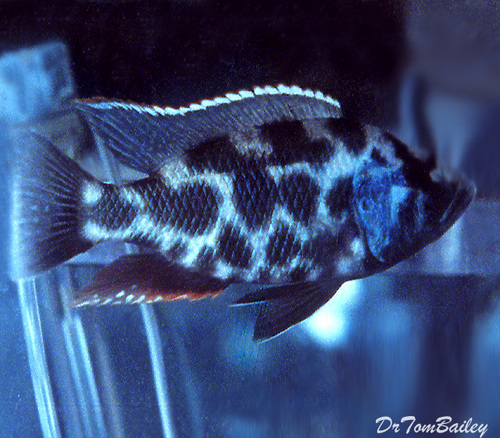
Premium Lake Malawi Livingstonii Hap
Above: In this picture a young male Premium Lake Malawi Livingstonii Hap is swimming in one of our aquariums, when one of us snapped this picture.
Comments: These are fabulous fish with a camouflage pattern. This fish lies on the bottom and turns a grayish dead looking color. When young fish come to investigate, they are swallowed. So this fish is sometimes call a "Sleeper"!
Origin: The ancestors of Livingstonii Haps lived only in Lake Malawi in East Africa. But now they live in aquariums all over the world.
There are often a few other Hap species for sale in this store. All the Malawi Haps are said to live away from the piles of huge rocks in Lake Malawi, where the more aggressive Mbunas live.
Maximum Size: In aquariums, males are said to grow to be about 12" long, but so far we haven't seen one bigger than about 8" long , including their tails, which is a very nice size for aquariums.
Females are smaller and remain grey without the brilliant colors shown by males.
Behaviors: All Haps are usually rather aggressive fish, but not as aggressive as the Mbunas that also originated in Lake Malawi.
Compatibility: Some recommended tank mates include, Malawi Peacocks, mild tempered Mbunas like the Lemon Yellow Mbuna, and Synodontis Catfish, also Cichlids from Lake Victoria, but probably not Cichlids from Lake Tanganyika.
Click here for more about Synodontis Catfish. Click here to read more about compatible groups of pet fish.
Temperature: Livingstonii Haps live best from about 75 to 80-degrees F. with 78 being perhaps ideal.
Click here to learn about aquarium temperature, aquarium thermometers, and aquarium heaters.
Feeding: Premium Fish Food Pellets is the best food for Cichlids to eat. It would be best to feed them small pellets when they're small, then gradually increase the size as they grow bigger.
In Lake Malawi the Livingstonii Haps eat small fish but do not require live fish when living in an aquarium. Click here to learn more about and shop online for premium fish foods.
Water Conditions: Lake Malawi has hard alkaline water and that's best for all the fish, whose ancestors lived there.
But these fish can adapt to most types of water, and so as usual it's best not to try to change the pH or alkalinity.
Click here for a lot more information about aquarium water conditions.
Aquarium Size: Livingstonii Haps will eventually need to live in an aquarium with at least 80-gallons of water.
Each Hap will need at least 5-gallons of water, and these fish live best in an aquarium with at least 12 other compatible Cichlids of about the same size.
Decor: Livingstonii Haps do not need gravel, and a layer of gravel more than 1/4" thick will usually fill with bits of uneaten food that will contaminate the water.
Click here for more about aquarium gravel.
Live plants are beautiful and improve the water quality, but this fish will usually dig plants up, so most aquariums with Livingstonii Haps do not have live plants.
They like medium size gravel about the size of rice mixed with a few aquarium-safe rocks.
Aquarium Filter: Bio-Wheel Filters are highly recommended.
Most 80-gallon aquariums have room along the back for two Penguin 350B Filters, and this is sort of the minimum set up for these fish.
Better is a 120, 150, or 200-gallon aquarium with as many Penguin 350B Filters as will fit across the back.
Click here to learn more about aquarium filters.
The addition of Lava Rocks will keep nitrates in the ideal range.
Click here to learn more about using Lava Rocks in aquariums.
Life Span: Livingstonii Haps can live for several years.
Keep the water conditions excellent and feed them premium foods, and they'll most likely breed and produce the next generation of fish for your aquarium.
Gender: It's difficult to tell males from females, when they're very small, but easy when they are mature, because the males grow bigger with more red on their fins, eggs spots on their fins that become more pointed, and eventually a male gets a dazzling metally blue sheen on his body.
Breeding: Livingstonii Haps are mouthbrooders.
A female lays eggs, a male fertilizes the eggs, and the female picks up the eggs in her mouth.
She'll brood her eggs for about 3-weeks, then release them in the aquarium. They are miniature versions of their mother and very cute!
Click here to read more about breeding mouthbrooders. the aquarium.
Click here for a lot more about breeding various tropical fish in aquariums.
Popularity: For a long time the Livingstonii Hap from Lake Malawi has been a very popular aquarium fish.
The males are one of the most beautiful freshwater fish in the world.
Names: Their scientific name is Nimbochromis livingstonii.
Variations: There are no variations of this species that are known to us.
Click here for a lot more information about keeping and caring for Livingstonii Haps, including a picture gallery.
We hope you've enjoyed reading these comments.
DrT - 01/21/2015
Why Us?
All of our fish are Premium Quality Fish from the best suppliers in the world. Our fish have better health, more energy and brighter colors, as you can see in our pictures on this website.
We have 380-aquariums with lots-and-lots of popular aquarium fish plus lots-and-lots of rare fish!
We consider ourselves to be the link between the world's best sources of fish and the world's best customers. We love our work, and we are very responsible about caring for our fish and then shipping them carefully.
We also offer lots and lots of information about keeping and caring for pet fish, all from the knowledge of the Bailey Brothers, who have a combined total of 100+ years of experience as breeders, wholesalers, and retailers of pet fish!
Our fish and our customers are treated with the best of care, and we work energetically everyday to make sure every customer enjoys their new fishy friends.
When you purchase pet fish from us, you know you're receiving premium quality fish and premium quality service.
"Received my fish last night and was so pleased! They all arrived alive and appeared to be healthy.
"Once in the tank, they became very active and are now thriving in their new home.
"Beautiful fish, I asked for color and aquariumfish delivered. Processing and shipping was extremely quick."

About AquariumFish.net

Nevin and DrTom, the Bailey Brothers
This website is owned and operated by the Bailey Brothers, DrTom and Nevin, who've been together in the fish business for more than 50-years.
The Product Manager has been with the company for more than 35-years.
So we feel very confident that this is the fishiest crew anywhere.
